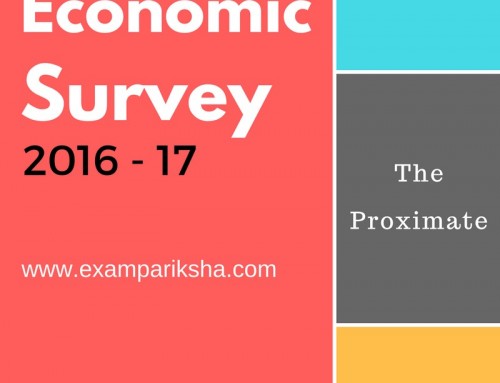The Pink-color Economic Survey 2017-18 was tabled in Parliament by the Union Minister for Finance and Corporate Affairs, Arun Jaitley. The pink coloured cover is seen as a symbol of support for the growing global movement to end violence against women (#MeToo) which spans continents. It also points to critical challenges for the Indian economy in form of addressing the deep societal meta-preference for Sons and empowering women with education and reproductive and economic agency.
This year’s Economic Survey has come in two volumes at the same time, reverting back to the older practice “in response to popular demand”. For 2017-18’s Economic survey:
- Volume-1 contains the research-cum-analytical overview.
- Volume-2 provides a descriptive review of the current fiscal year, incorporating all the major sectors of the economy
The Economic Survey has mined Big Data, like last year, to shed light on the economy. This has led to some epiphanic understanding for the authors (Ministry of Finance, Department of Economic Affairs, Economic Division). For instance, a whole new perspective has been gained from data about GST implementation and EPFO/ESIC analysed together.
About Big data:
It refers to technologies and initiatives that involve highly diverse data that is too massive for conventional technologies, skills and infra- structure to address efficiently. This type of data requires a different processing approach called big data, which uses massive parallelism to derive conclusions otherwise uninterpretable.
The Survey highlight ten new interesting economic facts about the country:
1 – The large increase has been recorded in registered indirect and direct taxes, post-GST implementation. There has been a fifty percent increase in the number of indirect taxpayers. There has also been a large increase in voluntary registrations, especially by small enterprises that buy from large enterprises wanting to avail themselves of input tax credits.
2 – Formal non-agricultural payroll is much greater than earlier believed. It became evident that when “formality” was defined in terms of social security provisions like EPFO/ESIC the formal sector payroll was found to be about 31 percent of the non-agricultural workforce. When “formality” was defined in terms of being part of the GST net, such formal sector payroll share was found to be 53 percent.
3 – For the first time in India’s history, data on the international exports of states has dwelled in the Economic Survey. States’ prosperity is positively correlated with their international and inter-State trade, indicating a strong correlation between export performance and states’ standard of living. States that export internationally and trade with other states were found to be richer. The Survey pointed out that five states – Maharashtra, Gujarat, Karnataka, Tamil Nadu and Telangana – accounted for 70 percent of India’s exports.
4 – India’s firm export structure is substantially more egalitarian than other large economies. The largest firms (top 1 percent) account only for 38% of exports unlike in other countries where they account for substantially greater share – (72, 68, 67 and 55 percent in Brazil, Germany, Mexico and USA respectively).
5 – Export incentives do work, as clothing incentive package has boosted exports of readymade garments. The Rebate of State Levies (ROSL) has increased exports of ready-made garments (man-made fibres) by about 16 percent but not of others.
6 – Indian parents’ exhibit a strong desire for a male child, a seemingly known fact about the Indian society. It pointed out that most parents continued to have children until they get the desired number of sons. The survey arrives at a figure of 21 million unwanted girls by looking at the Sex Ratio of the Last Child (SRLC) which is heavily male-skewed. This is a direct outcome of the ‘Son meta preference’ where parents do not stop having children after having a daughter. The survey gave details of various scenarios leading to skewed sex ratios and also gave a comparison of sex ratio by birth between India and Indonesia.
7 – Substantial avoidable litigation by tax authorities (largest litigant in India) could be reduced by government action. The survey pointed out that tax departments in India have pursued several tax disputes albeit with a low success rate which is below 30 percent. About 66 per cent of pending cases accounted for only 1.8 per cent of value at stake. Survey has called for coordinated action between government and the judiciary to address the delays and boost economic activity.
8 – Raising investment is more important than raising saving for growth. The survey indicated that growth in savings did not bring economic growth but the growth in investment is proving to be more important for re-igniting the economic growth.
9 – Direct tax collections by States and local governments are significantly lower than those of their counterparts in other federal countries. A comparison has been given between ratios of the direct tax to total revenues of local governments in India, Brazil and Germany.
10 – Extreme weather adversely impacts agricultural yields, twice as heavily in un-irrigated areas than in irrigated ones. The survey captures the footprints of climate change on India and consequent adverse impact on agricultural yields. With increasing extreme temperature, the consequent deficiency in rainfall have been captured on the Indian map and the graphical changes in agricultural yields are brought out from such data.
The 2018 Economic Survey has estimated that the Indian economy will grow by 7-7.5% in 2018-19, thereby re-instating India as the world’s fastest-growing major economy. The Survey pegs that the second half of Financial Year 2018 can clock a 6.75% growth owing to a pick-up in exports and the base effect from poor fourth-quarter growth in Demonetisation-hit 2016-17.





